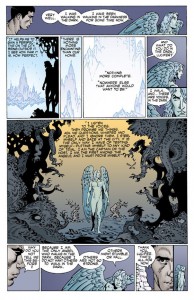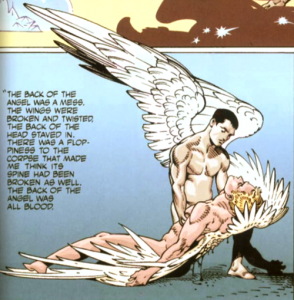
![]() Neil Gaiman’s Murder Mysteries adapted for comics by P. Craig Russell
Neil Gaiman’s Murder Mysteries adapted for comics by P. Craig Russell
P. Craig Russell’s artwork is stunning in his adaptation of Neil Gaiman’s Murder Mysteries. And since the story has all the other-worldly hallmarks of a Neil Gaiman Sandman story, Russell really gets a chance to show off his talent as he bounces from the angelic Silver City to the cityscapes of our mundane world.
This graphic novel is based on what was originally a short story by Neil Gaiman (and eventually a radio drama in the spirit of The Shadow); I read the comic before seeking out the story, so I can say that if I had not been told that the story had been adapted, I would think it had been designed solely for this graphic format.
Since I’m writing about Murder Mysteries (with an emphasis on mystery), it’s difficult to say much about the plot without giving away spoilers. However, Gaiman gives readers a little clue to the tale in his introduction to the collection of his short stories Smoke and Mirrors: Short Fictions and Illusions. Gaiman, seeming to play the role of Agatha Christie, teasingly asks us to pay careful attention to the title: “I tried to play fair with the detective part of the story. There are clues  everywhere. There’s even one in the title.” That’s a great tease from Gaiman, isn’t it?As regular readers of this column know, my favorite genre is noir, specifically the male P.I., so this story is of particular interest to me since Gaiman’s tale is not only a record of the first murder, but also the revelation of the identity of the first P.I., a member of the angelic host.
everywhere. There’s even one in the title.” That’s a great tease from Gaiman, isn’t it?As regular readers of this column know, my favorite genre is noir, specifically the male P.I., so this story is of particular interest to me since Gaiman’s tale is not only a record of the first murder, but also the revelation of the identity of the first P.I., a member of the angelic host.
The story takes place in the Silver City before creation: We meet the main angelic creators of our world as they wrestle with various concepts that will be a part of our world. And we meet Raguel as Lucifer tells him for the first time his function: “You are Raguel. The Vengeance of the Lord.” Lucifer at this point in the story is still a strong supporter of God, and he does his duty in telling Raquel his mission: “You must find who was responsible for this. And how — and take the vengeance of The Name on whoever caused this thing to happen.” We now have our very first righteous detective on the hunt to discover the very first killer who enacted the first murder of all time before there even was time.
 This plot would be enough for any good, run-of-the-mill writer, but we know we’ll get more than just a murder mystery since it’s coming from the mind of Neil Gaiman. Without giving too much detail, let me mention a few of the other qualities that really strengthen the book. First, the story of the angels is framed by another story in our world. The narrator of the book is actually a human being who is telling us, the readers, about being told the story of the angels by a stranger sitting with him on a bench. The stranger asks for a cigarette and pays for it with a story, the story of the angels. This framing device is more than just a clever set-up for delivering the main story to us: The two stories are linked by character and by theme. Other than that, I’ll tell you no more on that topic so as to avoid spoilers.
This plot would be enough for any good, run-of-the-mill writer, but we know we’ll get more than just a murder mystery since it’s coming from the mind of Neil Gaiman. Without giving too much detail, let me mention a few of the other qualities that really strengthen the book. First, the story of the angels is framed by another story in our world. The narrator of the book is actually a human being who is telling us, the readers, about being told the story of the angels by a stranger sitting with him on a bench. The stranger asks for a cigarette and pays for it with a story, the story of the angels. This framing device is more than just a clever set-up for delivering the main story to us: The two stories are linked by character and by theme. Other than that, I’ll tell you no more on that topic so as to avoid spoilers.
Secondly, the book impresses with Gaiman’s typical interest in theology and philosophy. The book, while having a concrete plot, also reveals an interest in theoretical concerns. Gaiman’s angels design creation and all that goes into it and not just the physical aspects. They design all aspects of our existence, we are told, from “Dimension” to “Sleep.” However, the story focuses on the larger, more difficult, concepts they are designing: Regret, Love, and Death. And these concepts thematically permeate both the story of the Silver City and the framing narrative.
 “Memory” is another key concept in the graphic novel. But unlike the other concepts, it is addressed first in the comic, not in the Silver City, but in the worldly city of our framing narrative as our main, human narrator reflects on the potential frailty of human memory: “Memory is the great deceiver. Perhaps there are some individuals whose memories act like tape recordings. Daily records of their lives complete in every detail, but I am not one of them. My memory is a patchwork of occurrences. Some sections seem to have vanished completely.” Of all the major subjects addressed in the book, Memory is perhaps the easiest to overlook, but it, too, plays a role in both narratives and is of concern when a key choice must be made by our detective angel.
“Memory” is another key concept in the graphic novel. But unlike the other concepts, it is addressed first in the comic, not in the Silver City, but in the worldly city of our framing narrative as our main, human narrator reflects on the potential frailty of human memory: “Memory is the great deceiver. Perhaps there are some individuals whose memories act like tape recordings. Daily records of their lives complete in every detail, but I am not one of them. My memory is a patchwork of occurrences. Some sections seem to have vanished completely.” Of all the major subjects addressed in the book, Memory is perhaps the easiest to overlook, but it, too, plays a role in both narratives and is of concern when a key choice must be made by our detective angel.
Overall, this graphic novel, or story, is worth getting as a trade collection, even if you must track down a used copy (it’s out of print as far as I can tell). I haven’t said enough about P. Craig Russell’s fantastic art, but it alone is worth the price of the book. I think one potential disappointment is feeling like the story is too short, and perhaps it is too brief for all the concepts and ideas packed into it. You almost wish it were fleshed out. But, in the end, I think the story is just the right length for Gaiman’s purposes.
 If one feels the story is too short, I must return to the advice I gave, and want to repeat often, in my essays on “How to Read Comics.” The advice I give is the advice I often need: Slow down and look at the pictures. I know that sounds obvious, but if you are not a frequent comic book reader and have spent years training your eyes to focus on linear text as most of us have, it is difficult to train your eyes not to merely hunt for the next words, often flipping pages without even looking at the pictures. I often find that I miss a good percentage of the artwork because I didn’t grow up reading comics. In other words, chalk it up to bad education (and why, as an important side note, I believe we need more rather than fewer comics in the public school curriculum in order to facilitate better skills in textual analysis).Returning to my point about this book’s being too short, I’d say that if one takes the time to closely look at and study the pictures and read through it at least twice, a reader will find that it’s no longer “too short.” Yes, you can read the story quickly, but you shouldn’t. Savor this story. And if you like it and want more, go read the entire run of Neil Gaiman’s Sandman, the best long run of comics ever written and drawn as far as I’m concerned. This story is an excellent sampler for his greatest work of art.
If one feels the story is too short, I must return to the advice I gave, and want to repeat often, in my essays on “How to Read Comics.” The advice I give is the advice I often need: Slow down and look at the pictures. I know that sounds obvious, but if you are not a frequent comic book reader and have spent years training your eyes to focus on linear text as most of us have, it is difficult to train your eyes not to merely hunt for the next words, often flipping pages without even looking at the pictures. I often find that I miss a good percentage of the artwork because I didn’t grow up reading comics. In other words, chalk it up to bad education (and why, as an important side note, I believe we need more rather than fewer comics in the public school curriculum in order to facilitate better skills in textual analysis).Returning to my point about this book’s being too short, I’d say that if one takes the time to closely look at and study the pictures and read through it at least twice, a reader will find that it’s no longer “too short.” Yes, you can read the story quickly, but you shouldn’t. Savor this story. And if you like it and want more, go read the entire run of Neil Gaiman’s Sandman, the best long run of comics ever written and drawn as far as I’m concerned. This story is an excellent sampler for his greatest work of art.



I loved the artwork in this one, and the tone. Frankly,I thought the story was a little predictable, but the subtext about Lucifer and God that was nicely done.
I really need to read this as a graphic novel — even in plain text form it has a lot of between-the-lines hints. I can just imagine what an artist could do with it.